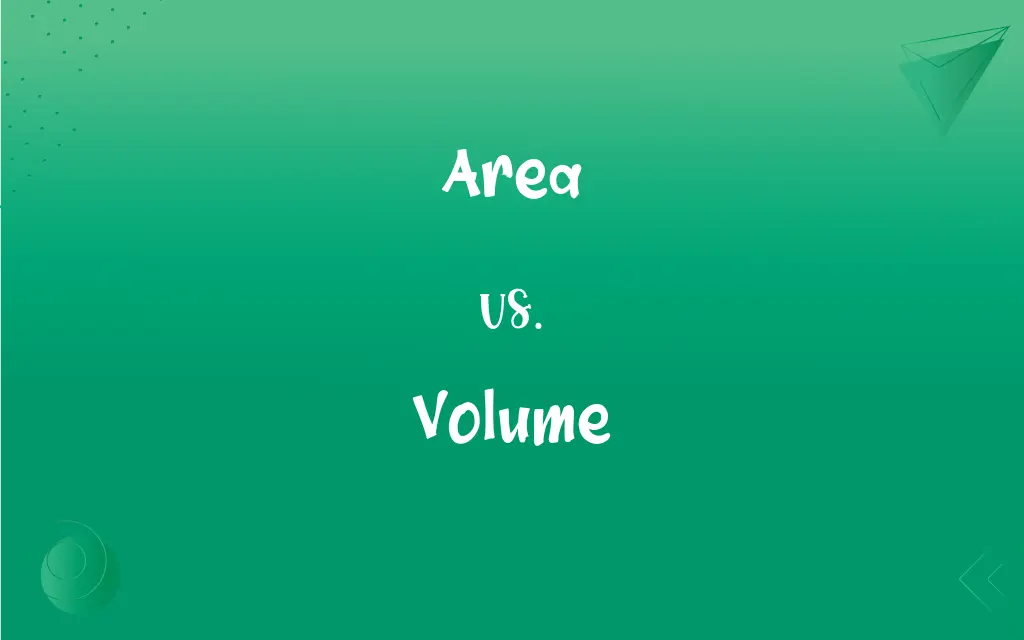Area vs. Volume: What's the Difference?
Edited by Aimie Carlson || By Harlon Moss || Updated on October 16, 2023
Area is the extent of a 2-D surface, measured in square units, while volume is the space a 3-D object occupies, measured in cubic units.

Key Differences
Area refers to the measure of space taken up by a two-dimensional surface, a concept applied in various fields like geometry and geography. In contrast, volume is concerned with the space that a three-dimensional object occupies, taking into account not just the surface area but the space it fills.
Calculating area often requires simple formulas depending on the shape, like length times width for rectangles. Calculating volume, however, typically involves more complex formulas that consider depth as well, such as length times width times height for a cube or rectangular prism.
Area is measured in square units, which can be square inches, square feet, square meters, or others, indicating the extent of a surface. Volume, on the other hand, is measured in cubic units, such as cubic centimeters, cubic meters, or liters, representing the capacity of space an object can hold.
In practical applications, area might be used to determine the size of a piece of land, the surface of a table, or the size of a wall to be painted. Volume is used in different contexts, like knowing the capacity of a container, the amount of water a swimming pool holds, or the space within a room.
Both area and volume are fundamental concepts in mathematics and physics. Area is crucial for understanding surface coverage or size, while volume is essential for analyzing the space objects occupy or the capacity of containers in real-world situations.
ADVERTISEMENT
Comparison Chart
Dimensionality
2-Dimensional
3-Dimensional
Measurement
Measured in square units
Measured in cubic units
Formulas
Simpler formulas (e.g., length x width)
More complex formulas (e.g., length x width x height)
Practical Application
Used for measuring surfaces
Used for determining capacity
Concept
Concerns the extent of a surface
Concerns the space an object occupies
ADVERTISEMENT
Area and Volume Definitions
Area
The extent of a two-dimensional surface or piece of land.
The area of the park is 500 square meters.
Volume
A book forming part of a work or series.
She finished reading the final volume of the trilogy.
Area
A specific region or section of a larger space.
We decided to picnic in a shady area of the beach.
Volume
The amount of space that a substance or object occupies.
The volume of the container is 20 liters.
Area
The subject or range of activity or interest.
She's an expert in the area of environmental law.
Volume
The measure of the three-dimensional space within a container.
The volume of the suitcase determines how much it can hold.
Area
A geographic region or district.
This area is known for its historic landmarks.
Volume
The degree of loudness or intensity of a sound.
He turned up the volume when his favorite song started.
Area
The scope of a surface, considering length and width.
The total area of the canvas was covered in bright paint.
Volume
Quantity or amount of something, often in extensive quantities.
The volume of mail increases during the holiday season.
Area
A roughly bounded part of the space on a surface; a region:a farming area; the New York area.
Volume
A collection of written or printed sheets bound together; a book.
Area
A surface, especially an open, unoccupied piece of ground:a landing area; a playing area.
Volume
One of the books of a work printed and bound in more than one book.
FAQs
What units are used to measure volume?
Volume is measured in cubic units like cubic inches, cubic feet, cubic meters, or liters.
What does area measure?
Area measures the extent of a two-dimensional surface or space.
How is area calculated for a square or rectangle?
For squares and rectangles, the area is calculated as length multiplied by width.
How do you calculate the volume of a box?
The volume of a box is calculated as length multiplied by width multiplied by height.
Does volume indicate weight?
No, volume measures space, not weight, though it can relate to weight through density.
How is volume defined?
Volume is defined as the space occupied by a three-dimensional object.
Does volume only apply to solid objects?
No, volume can also describe the space filled by liquids and gases.
What's the difference between volume and capacity?
Volume refers to the space an object occupies, while capacity refers to the amount a container can hold.
Can area be applied to irregular shapes?
Yes, area can be calculated for irregular shapes using various mathematical methods.
Is area a vector quantity?
No, area is a scalar quantity; it has magnitude but no direction.
Where is area commonly used?
Area is used in fields like construction, geography, and art, among others.
What are practical applications of volume?
Volume is essential in cooking, shipping, construction, and science, for example.
Do area and volume consider depth differently?
Yes, area involves only length and width, while volume also considers depth.
In what units is area typically measured?
Area is typically measured in square units like square inches, square feet, or square meters.
Is volume a scalar or a vector quantity?
Volume is a scalar quantity; it has magnitude but no direction.
Can area be measured in three-dimensional space?
Area measures a two-dimensional space; for three dimensions, you consider volume.
What shapes have both area and volume?
All three-dimensional shapes have both area (surface area) and volume.
How does area relate to perimeter?
The perimeter is the boundary length of a two-dimensional shape, while the area is the space within those boundaries.
Are there shapes without area or volume?
No, all shapes have area, and all three-dimensional shapes have volume.
Can area determine room size?
Yes, the area can indicate the size of a flat surface, like a room's floor.
About Author
Written by
Harlon MossHarlon is a seasoned quality moderator and accomplished content writer for Difference Wiki. An alumnus of the prestigious University of California, he earned his degree in Computer Science. Leveraging his academic background, Harlon brings a meticulous and informed perspective to his work, ensuring content accuracy and excellence.
Edited by
Aimie CarlsonAimie Carlson, holding a master's degree in English literature, is a fervent English language enthusiast. She lends her writing talents to Difference Wiki, a prominent website that specializes in comparisons, offering readers insightful analyses that both captivate and inform.































































